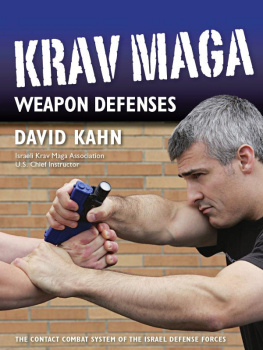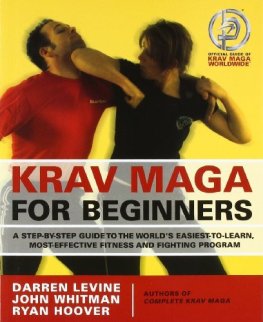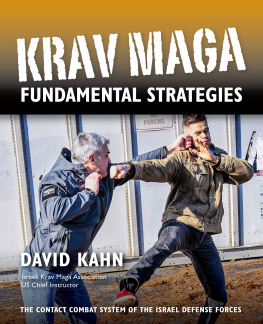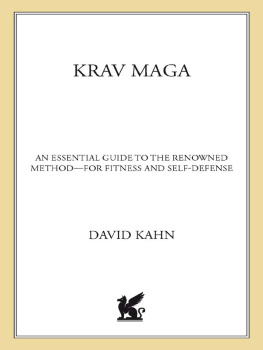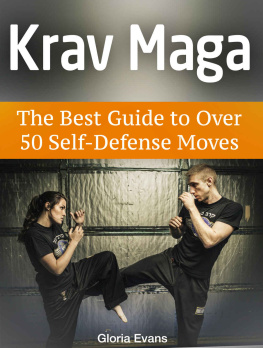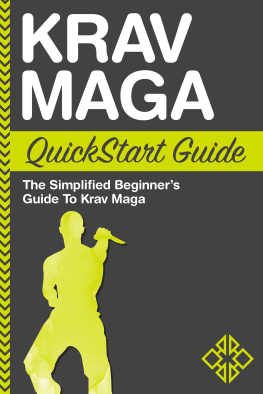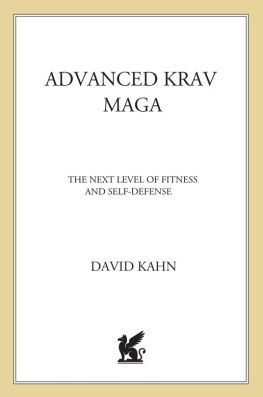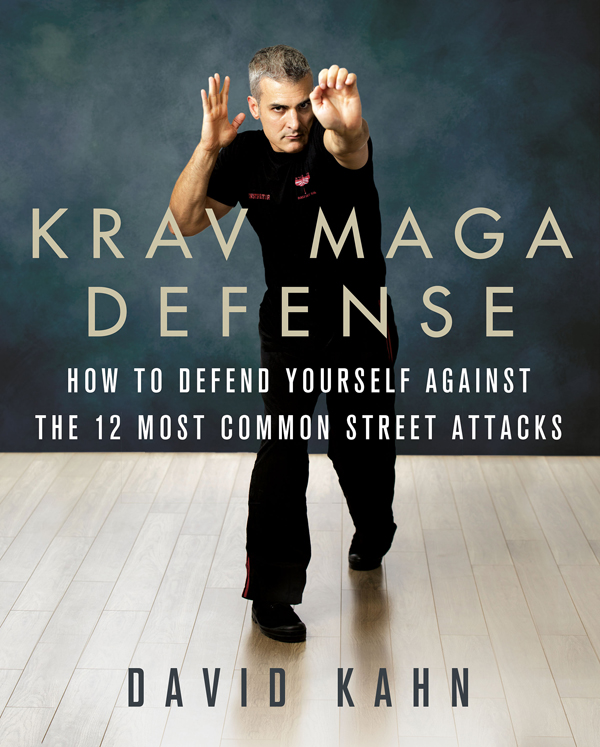Contents
Guide


The author and publisher have provided this e-book to you for your personal use only. You may not make this e-book publicly available in any way. Copyright infringement is against the law. If you believe the copy of this e-book you are reading infringes on the authors copyright, please notify the publisher at: us.macmillanusa.com/piracy.
For Claire, Benjamin, and Leo
In Memory of Al Blitstein, who stormed Omaha Beach in WW II to help liberate Europe, was Imi Lichtenfelds friend, and was one of krav magas greatest friends. He is missed.
THE MATERIAL OFFERED IN THIS BOOK IS a compact, essential overview of krav magas core techniques for defending against and defeating what I consider to be the twelve most common unarmed street attacks:
1. Pushes
2. Arm and shirt grabs
3. Hook or haymaker punches
4. Straight punches
5. Kick or knee attacks to the groin
6. Headbutts
7. Chokes and headlocks
8. Takedowns
9. Bear hugs
10. When on your back
11. Mounts
12. Guards and stomps
Also included is a brief overview of specific subtopics and tactics to avoid violence:
1. An introduction to violence and the krav maga mind-set
2. Preconflict indicators
3. Conflict avoidance
4. Conflict de-escalation
5. Conflict escape and evasion
6. The mind and bodys reactions when confronted with physical violence
While entire chapters or even books could be devoted to each of these subtopics, in the interest of providing a concise approach, I have attempted to introduce some of the most significant discussion and learning points and to make these topics accessible to all levels of practitioners. I have purposefully repeated certain strategic and tactical precepts, as the importance of these krav maga tenets cannot be overemphasized.
Krav maga, the Israeli self-defense system, was created by the late Imi Lichtenfeld. Grandmaster Haim Gidon, the current president of the IKMA (Israeli Krav Maga Association), continually strives to develop, enhance, and improve the krav maga system on a daily basis. I hope this book serves as a solid introduction for those interested in learning more about krav maga. It also is designed to complement my previous two books, Krav Maga: An Essential Guide and Advanced Krav Maga along with DVD Volume IV Mastering Krav Maga: Defending the 12 Most Common Unarmed Attacks. In addition, I hope this information provides an instructive review for seasoned krav maga practitioners and martial artists alike, as it touches on several key core-technique subtleties. Representative of our teaching aims, I quote the late, great Gracie Jiu-Jitsu grandmaster Helio Gracie, To teach those who dont know, to remind those who do know, to correct those who think they know. For those who convert this material and represent it as their own without attribution, you know who you are and we know who you are.
BECAUSE NOT ALL KRAV MAGA IS THE SAME TM
Responsible people pursue Israeli krav maga training to shield themselves from violence, not to orchestrate violence. The kravist trains and prepares himself to face down the unfortunate, ugly specter of violence. Krav maga training, by both necessity and resultant design, focuses on the realistic and brutal nature of a physical assault. This self-defense and fighting system is designed to thwart and neutralize any type of threat or attack. The key survival ingredient is your mind-set. Those who train physically and mentally to preempt and, if necessary, thwart violence with overwhelming counterviolence will respond differently from people who do not condition themselves.
You, the kravist, when threatened or attacked, must unleash a torrent of overwhelming counterviolence. (This assumes there is no peaceful option and the circumstances are legally justified.) Krav magas goal is to neutralize an attacker quickly and decisively. If you must defend yourself, krav maga enables you to effectively stun, incapacitate, and, if necessary, control your attacker. Your honed, instinctive reaction will turn the tables on your attacker(s) immediately. Krav maga tactics are designed as defensive-capability multipliers. A few mastered krav maga techniques are highly effective in most situations. When properly learned and practiced, these tactics will become first nature.
CONFLICT AVOIDANCE
Nonviolent conflict avoidance is always your best solution. The following is the most important lesson krav maga can teach you: Do not to be taken by surprise or caught in the -5. (The -5 is when one is unprepared to fight for ones life.) Becoming an accomplished observer helps you resolve a situation before it fully evolves or gets out of hand. By constantly surveying your locale and its dynamics, you will notice at all times who and what surrounds you.
Walking away from a confrontation is a test of mental discipline and moral fiber. For example, if a situation involves someone taunting you, attempting to embarrass you, or assert social hierarchy, take the sensible action and walk away. Should you (correctly) walk away, be sure to disengage with a heightened sense of potential confrontation awareness. Until you are safe, continue to maintain both a mental and physical preparedness to spring into action. Extricating yourself from a potentially violent situation is both wise and pragmatic for myriad reasons, including avoiding potential injury to you and your family and avoiding criminal and civil liability proceedings.
Use common sense, basic precautions, and a confident demeanor to minimize your chances of being targeted and assaulted. Notwithstanding these preventive measures, accept the possibility of violence targeting you. There are several types of violence, including social, criminal, sociopathic, and professional. Statistically, you are most likely to face the first or second categories, social or criminal, respectively. Terrorism usually falls into a blend of the latter two categories. While you need not live in fear, denial is the most common obstacle to taking appropriate action. This is why you must be prepared, if you must face down a violent situation. Sharpen your mental and physical skills so you can implement them without thinking.
INSTINCTIVE, AGGRESSIVE REACTION IS REQUIRED
When in danger, your brain and body respond reflexively. Therefore, your self-defense reaction must be both instantaneously reflexive and instinctive. If you are in a fight and an attacker makes an unanticipated or unrecognized action, the brain cannot find a practiced response, resulting in decision paralysis. By training to respond, you will call upon your instincts and reflexes when attacked. With proper training, you will learn to conquer your fear and to control the energy and power from your bodys fight-or-flight response. Realistic training is designed to eliminate the third human reaction, a freeze response. You will learn not to freeze under pressure. While it is unusual to be in a situation where you must fight for your life, it does happen. You must be prepared.
Krav maga harnesses your natural abilities for you to (re)act optimally with little cognitive interference. With practice, you will be able to explode into action. Your attacker will literally not know what hit himrepeatedly. Only serious, hard, and appropriate training can trigger this fighting response. If push comes to shove, literally and figuratively, krav maga is designed to handle any type or number of assaults. For a kravist, there are no set solutions for ending a fight. A kravist may have different physical strengths and capabilities. He may have a strong kick or hand-strike capabilities; or strong infighting; or throwing skills; or takedowns, etc. This book will provide you some of the simplest and most effective defensive and counterattack measures.







